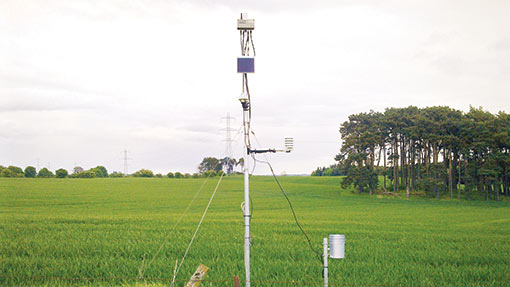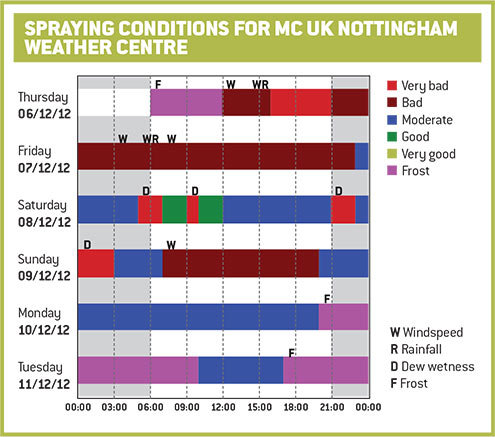On-farm weather stations improve forecast accuracy

Keeping an eye on the weather forecast is an essential part of being a grower and having a better understanding of what it is likely to do can pay dividends when it comes to predicting, preventing and controlling crop diseases.
A forecasting system that gives farmers more accurate disease forecasts by incorporating data from on-farm weather stations has been trialled for the first time on arable farms this season.
Developed by Agrovista’s Plantsystems team, the Daily Weather Forecast service and its disease forecasting extension, Daily Forecast Xtra, are helping growers to hone their spray programmes, says the firm’s agronomist Andy Steven.
The service covers 44 diseases and five pests on 21 crops species and is aimed predominantly at the horticulture and vegetable sectors. But it is now helping mainstream arable crops – it was used by several potato growers during 2013.
“The basic daily forecast provides a local 10-day overview based on short-term modelling data and the farm’s postcode, as well as a two-day detailed forecast,” he says.
“However, it also provides a six-day prediction [see example, below] for spraying conditions, which we have found to be very accurate up to two days out and very useful for sorting out priorities beyond that.
“The weather includes all the usual parameters, and the spraying forecast includes predictions of wind speed, rainfall, dew and frost. Each day is divided into eight three-hour blocks, each of which is colour-coded to represent conditions ranging from very good to very bad,” says Mr Steven.
See also: Take care of hard water to up pesticide efficacy
Most growers also opt for Daily Forecast Xtra, which adds in data obtained from automatic weather stations situated on farm and uses a disease model to provide an overview of current and future infection risk specific to the farm’s locality. A wide range of disease models is available, mainly for specialist high-value crops, but now includes sclerotinia in oilseed rape, septoria in wheat and late blight in potatoes.
“This is where you really start seeing the benefits and gaining real value,” says Mr Steven. “It has proved itself as an accurate predictor of blight pressure, thanks to the supply of very accurate local information.”
Weather stations need to be sited on a representative area of the farm, although they generally provide reasonably accurate data up to a 10-mile radius.
“However, the more you have, the better the information, so we are trying to get groups of growers together to link areas and improve coverage while sharing the cost of doing so,” says Mr Steven.
Although the season was relatively benign blight-wise, last season’s experience suggests Daily Forecast Xtra will allow growers to change chemistry according to disease risk and even change timings and intervals where practicable, says Mr Steven.
“Environmental and end-market pressures mean growers have to be able to justify the use of inputs. This system helps them do that and potentially reduce cost and wastage at the same time.”
That is the conclusion that Phil Burgess, technical manager for The Co-operative Farms, is coming to. He is responsible for ensuring the 60,000t of potatoes grown annually by the business and its contract growers reach the stringent standards demanded by The Co-operative Group’s stores.
“The daily weather forecast is useful in itself,” he says. “It comes in a fairly simple format and the first two days in particular tend to be fairly reliable. The spray forecast also looks useful – 2013 was relatively easy in terms of blight control, but it would be useful if things turned a bit catchy, not just for potatoes, but to help organise all spraying operations across a whole farm.”
The Daily Forecast Xtra has already shown plenty of potential, despite the relatively benign year. “Experience has shown that we should have been more proactive. Just as by picking up periods of high blight pressure it would flag up the need to add a fungicide such as cymoxanil to increase kickback, this year we could have been braver given the largely low-pressure outlook that was forecast.
“In hindsight, we could have reduced the cost of our fungicide programme. Ours is pretty robust, using quite a lot of Revus (mandipropamid), Infinito (fluopicolide + propamocarb) and Ranman (cyazofamid + cymoxanil). We could have perhaps stepped back a bit and used older, cheaper products.
“We should perhaps also have looked at extending intervals a bit – though logistically that can be complicated on large operations where sprays are planned on a weekly basis, and it can also affect irrigation cycles.”


